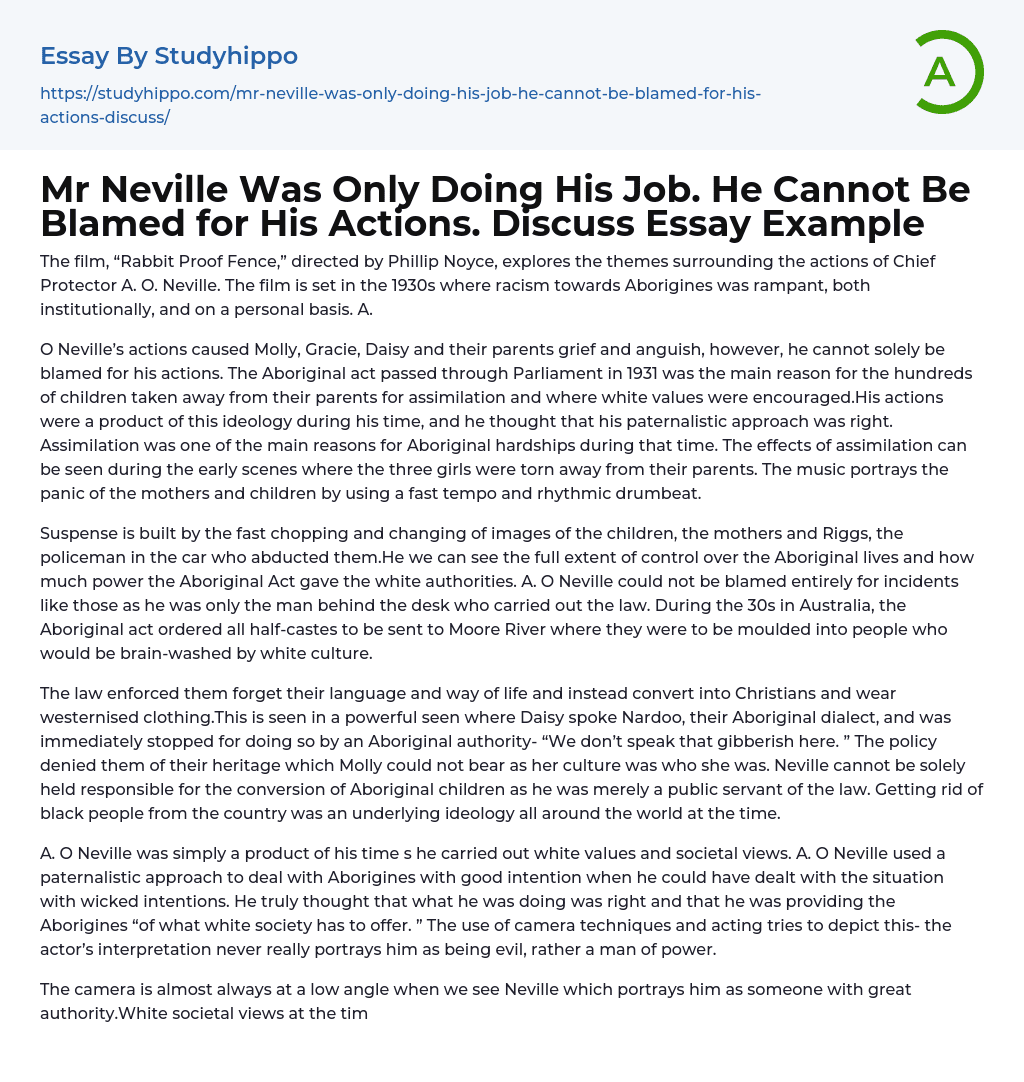

Mr Neville Was Only Doing His Job. He Cannot Be Blamed for His Actions. Discuss Essay Example
The film, “Rabbit Proof Fence,” directed by Phillip Noyce, explores the themes surrounding the actions of Chief Protector A. O. Neville. The film is set in the 1930s where racism towards Aborigines was rampant, both institutionally, and on a personal basis. A.
O Neville’s actions caused Molly, Gracie, Daisy and their parents grief and anguish, however, he cannot solely be blamed for his actions. The Aboriginal act passed through Parliament in 1931 was the main reason for the hundreds of children taken away from their parents for assimilation and where white values were encouraged.His actions were a product of this ideology during his time, and he thought that his paternalistic approach was right. Assimilation was one of the main reasons for Aboriginal hardships during that time. The effects of assim
...ilation can be seen during the early scenes where the three girls were torn away from their parents. The music portrays the panic of the mothers and children by using a fast tempo and rhythmic drumbeat.
Suspense is built by the fast chopping and changing of images of the children, the mothers and Riggs, the policeman in the car who abducted them.He we can see the full extent of control over the Aboriginal lives and how much power the Aboriginal Act gave the white authorities. A. O Neville could not be blamed entirely for incidents like those as he was only the man behind the desk who carried out the law. During the 30s in Australia, the Aboriginal act ordered all half-castes to be sent to Moore River where they were to be moulded into people who would be brain-washed by white culture.
The law enforced
them forget their language and way of life and instead convert into Christians and wear westernised clothing.This is seen in a powerful seen where Daisy spoke Nardoo, their Aboriginal dialect, and was immediately stopped for doing so by an Aboriginal authority- “We don’t speak that gibberish here. ” The policy denied them of their heritage which Molly could not bear as her culture was who she was. Neville cannot be solely held responsible for the conversion of Aboriginal children as he was merely a public servant of the law. Getting rid of black people from the country was an underlying ideology all around the world at the time.
A. O Neville was simply a product of his time s he carried out white values and societal views. A. O Neville used a paternalistic approach to deal with Aborigines with good intention when he could have dealt with the situation with wicked intentions. He truly thought that what he was doing was right and that he was providing the Aborigines “of what white society has to offer. ” The use of camera techniques and acting tries to depict this- the actor’s interpretation never really portrays him as being evil, rather a man of power.
The camera is almost always at a low angle when we see Neville which portrays him as someone with great authority.White societal views at the time are to be blamed for Aboriginal hardships and A. O Neville was a man of power with good intentions. We can see in “Rabbit Proof Fence” that A. O Neville cannot entirely be blamed for his actions but rather white ideology and the 1930 Aboriginal Act.
Although A.
O Neville made decisions that brought suffering to the girls and their mothers as well as other children who were assimilated at the time, he had good intentions. The blame should be placed on white society and laws that encouraged their views in the early nineteen-hundreds rather than the people who only enforced policies.



